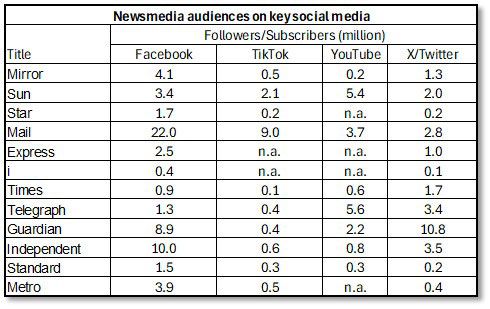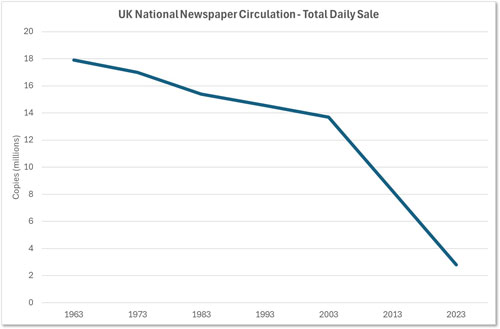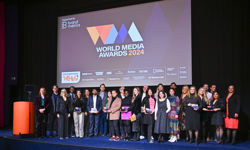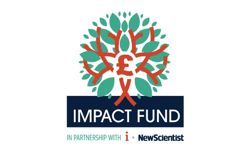
As the digital giants have grown to a point where they command 65% of global advertising, and 80% in the UK – the highest share in the world – half of which is in the hands of Alphabet and Meta – the relationship between publishers and their digital “partners” is at an all-time low.
First came Alphabet and Meta altering their algorithms resulting in news media losing pageviews due to falling search levels or page rankings. As News Corp reported recently1, this has had a direct impact on advertising revenues.
More recently, Nieman Lab2 reported that YouTube is redirecting traffic away from news, with “algorithmic redirection” programmed to direct the user to “something different than what you’re watching”.
Then along came Google’s ‘Privacy Sandbox’, intended to upgrade the digital value chain. The motive was logical, but Google’s error was a lack of consultation. Now after various legal interventions in the USA, Australia, the EU and UK, we learned recently that Google “will not kill off third-party cookies on its Chrome web browser after nearly five years of promising otherwise.3”
The most recent controversy surrounded the utilisation of news content to “train” AI systems, effectively “stealing” content from reputable – and presumably disreputable – websites only for it to be regurgitated, without acknowledgement as to its original source.
Governments have been compelled to intervene including the Australian government’s ‘News-Media and Digital Platforms Mandatory Bargaining Code’4’, the European Commission’s ‘Digital Markets Act’5, and recently the UK’s ‘Digital Markets Competition and Consumers Act’6 which is “paving the way for publishers [to have a] ‘level playing field’ with big tech… empowering publishers to reap fair reward.7”
But it is not just publishers who are frustrated by the digital landscape. Advertisers have voiced their own concerns for years.
It’s five years since Marc Pritchard, the long-time chief marketing officer at Proctor and Gamble, described the digital value chain between the advertiser and consumer as “murky at best, fraudulent at worst8”.

Just last month, InPublishing referred to a study9 by the American Association of National Advertisers which concluded that “just 36 cents of every dollar spent on programmatic advertising reaches the consumer, and a quarter of the $88 billion spent on open web programmatic is wasted on low-quality and fraudulent ad impressions.”
So, the introduction of legislation is creating a “more level playing field”, but what is required now is a new, more constructive “dialogue of equals” between all the stakeholders – publishers, advertisers, and their shared digital partners. Initially this could be at a UK national industry level, but ultimately, if the news media – and other legitimate content providers – together with advertisers will only maximise their position at a global level, by way of collaboration.
It was encouraging to note that Martin Sorrell, a doyen of the advertising industry, was a keynote speaker at the recent INMA international conference10. Sorrell was the person who coined the word “frenemy” when commenting on the relationship between advertisers and the digital giants back in 2014.
It was also encouraging that WAN-IFRA included several Google executives in their recent WAN-IFRA Congress11 programme.
What can be done
How might we get to an optimum partnership with our digital partners? Let me propose the following steps:
A dialogue between the news media owners and advertisers could identify issues of shared concern, from which an agenda to re-optimise their direct relationship can be defined. This would include examining the issues within the digital value chain as well as a structured response to Google’s Sandbox. One example of this is Dot Dash Meridith – the US’s largest consumer magazine publisher. They utilised AI to develop a system called ‘D/Cipher’ drawing data from 30 million visitors’ reading behaviour and response to advertising, across their forty brands. This enables advertisers to not only pin-point their most attractive prospects, but also tailor their messaging to them. It is a process that news media could emulate.
Initiatives like this greatly improve the direct – advertiser to medium – planning, booking and buying process, by-passing the digital players altogether.
There is a debate to be had regarding the definition of legitimate content and its players. Currently, content producers operate in silos – newspapers, magazines, broadcasters – those that are members of established trade associations, and those new entrants who are creating great content, largely ignored by the major players.
Significantly, another report, from the World Advertising Research Council noted that “brand safety tops list of programmatic concerns”.
Advertisers are seeking reputable environments to entrust their image and messaging. Perhaps some form of media legitimacy index would provide advertisers with a basis for effective campaign planning, in terms of media choice and “brand safety”, while also assisting smaller players and new entrants to attract new quality advertising revenues.
From here, publishers and advertisers will be better placed to respond to the goals of the digital players. Why did both Meta and Alphabet adjust their search algorithms and AI tools that downgraded the most legitimate news providers?
From my experience, Google have always been both receptive and responsive. Their News Innovation Initiative16 is testimony to that. Indeed, I first met Matt Brittin, the head of Google EMEA, when we were both working for Mirror Group, now Reach.
Meta I suspect, will be more challenging, but of all the social media platforms, Facebook is the most popular with publishers.
And as for X/Twitter? If I were a publisher or journalist today, I would be questioning whether I should be associated with Elon Musk’s “toXicity!”

I’ve been in the news industry now for 48 years, and for most of that time I have witnessed the steady decline in news consumption. But recently, I have become more optimistic about our future.
But this requires a realignment of the relationship between publishers, advertisers and their digital partners. This can only be achieved through co-operation and dialogue.

Footnotes:
5 digital-markets-act.ec.europa.eu
8 This quote was widely reported.
10 inma.org
11 wan-ifra.org












